Evaluation of Eight Decomposition-Hybrid Models for Short-Term Daily Reference Evapotranspiration Prediction
Abstract
1. Introduction
2. Materials and Methods
2.1. Study Area
2.2. Data Collection and PM-Equation
- Training set (80%): used to fit the model and estimate its parameters.
- Testing set (20%): used to evaluate the model’s predictive performance.
- Out-of-sample validation set: the final 10 days of the dataset—referred to as the prediction set in figures—were withheld and used exclusively to simulate a real-world forecasting scenario. This held-out segment enabled the assessment of the practical prediction capability of the decomposed hybrid model by comparing predicted ETo values with actual observation.
2.3. Decomposition Algorithms and LSTM
2.3.1. EMD, EEMD, and CEEMDAN
2.3.2. VMD
2.3.3. LMD
2.3.4. ESMD
2.3.5. DWT and EWT
2.3.6. LSTM
2.4. Parameter Setting for Hybrid Forecasting Algorithms
2.5. Statistical Analysis
3. Results
3.1. Accuracy Evaluation of Eight Decomposition Algorithms on AS and ETo
3.2. Accuracy Analysis of Eight Decomposition Hybrid Models in the ETo Test Sets
3.2.1. 5-Days Ahead Forecasting
3.2.2. 7-Days Ahead Forecasting
3.2.3. 10-Days Ahead Forecasting
3.3. Out-of-Sample Evaluation of Eight Decomposition Hybrid Models in Short-Term ETo Prediction
4. Discussion
4.1. The Influence of Sequence Complexity on Model Prediction Accuracy
4.2. The Reasons for Accuracy Difference of Hybrid Models in Testing and Prediction Sets
4.3. Research Inspiration on Decomposed Hybrid Models
5. Conclusions
Supplementary Materials
Author Contributions
Funding
Institutional Review Board Statement
Informed Consent Statement
Data Availability Statement
Conflicts of Interest
Abbreviations
| EMD | Empirical mode decomposition |
| EEMD | Ensemble EMD |
| CEEMDA | Complete EEMD with adaptive Noise |
| VMD | Variational mode decomposition |
| LMD | Local mean decomposition |
| ESMD | Extreme point symmetric mode decomposition |
| DWT | Discrete wavelet transformation |
| EWT | Empirical wavelet transformation |
| LSTM (M0) | Long short-term memory neural network |
| M1 | EMD-LSTM hybrid model |
| M2 | EEMD-LSTM hybrid model |
| M3 | CEEMDAN-LSTM hybrid model |
| M4 | VMD-LSTM hybrid model |
| M5 | LMD-LSTM hybrid model |
| M6 | ESMD-LSTM hybrid model |
| M7 | DWT-LSTM hybrid model |
| M8 | EWT-LSTM hybrid model |
| IMFs | Empirical mode intrinsic functions |
| ETo | Reference crop evapotranspiration |
| AS | Artificial sequence |
References
- Babaeian, F.; Delavar, M.; Morid, S.; Jamshidi, S. Designing climate change dynamic adaptive policy pathways for agricultural water management using a socio-hydrological modeling approach. J. Hydrol. 2023, 627, 130398. [Google Scholar] [CrossRef]
- Nouri, M.; Homaee, M.; Pereira, L.S.; Bybordi, M. Water management dilemma in the agricultural sector of Iran: A review focusing on water governance. Agric. Water Manag. 2023, 288, 108480. [Google Scholar] [CrossRef]
- Zhao, R.; Wang, H.; Chen, J.; Fu, G.; Zhan, C.; Yang, H. Quantitative analysis of nonlinear climate change impact on drought based on the standardized precipitation and evapotranspiration index. Ecol. Indic. 2021, 121, 107107. [Google Scholar] [CrossRef]
- Allen, R.; Pereira, L.; Raes, D.; Smith, M. FAO Irrigation and drainage paper No. 56. Rome Food Agric. Organ. United Nations 1998, 56, 26–40. [Google Scholar]
- Chen, Y.; Liu, X.; Ma, Y.; Zheng, C.; Zeng, Y.; Gao, W.; He, J.; Hao, L.; Liu, Z.; Shi, C.; et al. Regulating and remolding of soil water flux by sparse shrubs in arid desert regions. Catena 2024, 245, 108285. [Google Scholar] [CrossRef]
- Chen, Y.; Liu, X.; Ma, Y.; He, J.; He, Y.; Zheng, C.; Gao, W.; Ma, C. Variability analysis and the conservation capacity of soil water storage under different vegetation types in arid regions. Catena 2023, 230, 107269. [Google Scholar] [CrossRef]
- Dang, C.; Zhang, H.; Yao, C.; Mu, D.; Lyu, F.; Zhang, Y.; Zhang, S. IWRAM: A hybrid model for irrigation water demand forecasting to quantify the impacts of climate change. Agric. Water Manag. 2024, 291, 108643. [Google Scholar] [CrossRef]
- Pour, S.H.; Wahab, A.K.A.; Shahid, S.; Ismail, Z.B. Changes in reference evapotranspiration and its driving factors in peninsular Malaysia. Atmos. Res. 2020, 246, 105096. [Google Scholar] [CrossRef]
- Chen, Y.; Liu, X.; Zheng, C.; Ma, Y.; Gao, W.; He, J.; Hao, L.; Liu, Z.; Shi, C.; Cao, Q. Estimation of water budget components and its driving factors analysis in arid grassland. Sci. Total Environ. 2024, 906, 167654. [Google Scholar] [CrossRef]
- Hayat, M.; Zha, T.; Jia, X.; Iqbal, S.; Qian, D.; Bourque, C.P.A.; Khan, A.; Tian, Y.; Bai, Y.; Liu, P.; et al. A multiple-temporal scale analysis of biophysical control of sap flow in Salix psammophila growing in a semiarid shrubland ecosystem of northwest China. Agric. For. Meteorol. 2020, 288–289, 107985. [Google Scholar] [CrossRef]
- Li, X.; Zhai, J.; Sun, M.; Liu, K.; Zhao, Y.; Cao, Y.; Wang, Y. Characteristics of Changes in Sap Flow-Based Transpiration of Poplars, Locust Trees, and Willows and Their Response to Environmental Impact Factors. Forests 2024, 15, 90. [Google Scholar] [CrossRef]
- Guermoui, M.; Gairaa, K.; Ferkous, K.; Santos, D.S.d.O.; Arrif, T.; Belaid, A. Potential assessment of the TVF-EMD algorithm in forecasting hourly global solar radiation: Review and case studies. J. Clean. Prod. 2023, 385, 135680. [Google Scholar] [CrossRef]
- Chen, D.; Wang, Y.; Liu, S.; Wei, X.; Wang, X. Response of relative sap flow to meteorological factors under different soil moisture conditions in rainfed jujube (Ziziphus jujuba Mill.) plantations in semiarid Northwest China. Agric. Water Manag. 2014, 136, 23–33. [Google Scholar] [CrossRef]
- Wu, J.; Liu, H.; Zhu, J.; Gong, L.; Xu, L.; Jin, G.; Li, J.; Hauer, R.; Xu, C. Nocturnal sap flow is mainly caused by stem refilling rather than nocturnal transpiration for Acer truncatum in urban environment. Urban For. Urban Green. 2020, 56, 126800. [Google Scholar] [CrossRef]
- Chen, Z.; Zhang, Z.; Sun, G.; Chen, L.; Xu, H.; Chen, S. Biophysical controls on nocturnal sap flow in plantation forests in a semi-arid region of northern China. Agric. For. Meteorol. 2020, 284, 107904. [Google Scholar] [CrossRef]
- Núñez, J.; Rivera, D.; Oyarzún, R.; Arumí, J.L. On the use of Standardized Drought Indices under decadal climate variability: Critical assessment and drought policy implications. J. Hydrol. 2014, 517, 458–470. [Google Scholar] [CrossRef]
- Mouatadid, S.; Raj, N.; Deo, R.C.; Adamowski, J.F. Input selection and data-driven model performance optimization to predict the Standardized Precipitation and Evaporation Index in a drought-prone region. Atmos. Res. 2018, 212, 130–149. [Google Scholar] [CrossRef]
- Mandal, N.; Chanda, K. Performance of machine learning algorithms for multi-step ahead prediction of reference evapotranspiration across various agro-climatic zones and cropping seasons. J. Hydrol. 2023, 620, 129418. [Google Scholar] [CrossRef]
- Ahmadi, A.; Daccache, A.; Sadegh, M.; Snyder, R.L. Statistical and deep learning models for reference evapotranspiration time series forecasting: A comparison of accuracy, complexity, and data efficiency. Comput. Electron. Agric. 2023, 215, 108424. [Google Scholar] [CrossRef]
- Attri, I.; Awasthi, L.K.; Sharma, T.P.; Rathee, P. A review of deep learning techniques used in agriculture. Ecol. Inform. 2023, 77, 102217. [Google Scholar] [CrossRef]
- Coşkun, Ö.; Citakoglu, H. Prediction of the standardized precipitation index based on the long short-term memory and empirical mode decomposition-extreme learning machine models: The Case of Sakarya, Türkiye. Phys. Chem. Earth Parts A/B/C 2023, 131, 103418. [Google Scholar] [CrossRef]
- Zhang, Y.; Li, C.; Jiang, Y.; Sun, L.; Zhao, R.; Yan, K.; Wang, W. Accurate prediction of water quality in urban drainage network with integrated EMD-LSTM model. J. Clean. Prod. 2022, 354, 131724. [Google Scholar] [CrossRef]
- Goyal, P.; Kumar, S.; Sharda, R. A review of the Artificial Intelligence (AI) based techniques for estimating reference evapotranspiration: Current trends and future perspectives. Comput. Electron. Agric. 2023, 209, 107836. [Google Scholar] [CrossRef]
- Valipour, M.; Khoshkam, H.; Bateni, S.M.; Jun, C.; Band, S.S. Hybrid machine learning and deep learning models for multi-step-ahead daily reference evapotranspiration forecasting in different climate regions across the contiguous United States. Agric. Water Manag. 2023, 283, 108311. [Google Scholar] [CrossRef]
- Karbasi, M.; Jamei, M.; Malik, A.; Kisi, O.; Yaseen, Z.M. Multi-steps drought forecasting in arid and humid climate environments: Development of integrative machine learning model. Agric. Water Manag. 2023, 281, 108210. [Google Scholar] [CrossRef]
- Cao, Y.; Liu, S.; Cao, X.; Liu, X.; Hu, H.; Zhang, T.; Yu, L. EMD-based multi-algorithm combination model of variable weights for oil well production forecast. Energy Rep. 2022, 8, 13389–13398. [Google Scholar] [CrossRef]
- Wu, Y.; Meng, X.; Zhang, J.; He, Y.; Romo, J.A.; Dong, Y.; Lu, D. Effective LSTMs with seasonal-trend decomposition and adaptive learning and niching-based backtracking search algorithm for time series forecasting. Expert Syst. Appl. 2024, 236, 121202. [Google Scholar] [CrossRef]
- He, R.; Zhang, L.; Chew, A.W.Z. Modeling and predicting rainfall time series using seasonal-trend decomposition and machine learning. Knowl. Based Syst. 2022, 251, 109125. [Google Scholar] [CrossRef]
- Bazrkar, M.H.; Chu, X. Ensemble stationary-based support vector regression for drought prediction under changing climate. J. Hydrol. 2021, 603, 127059. [Google Scholar] [CrossRef]
- Ohana-Levi, N.; Munitz, S.; Ben-Gal, A.; Schwartz, A.; Peeters, A.; Netzer, Y. Multiseasonal grapevine water consumption—Drivers and forecasting. Agric. For. Meteorol. 2020, 280, 107796. [Google Scholar] [CrossRef]
- Fu, T.; Li, X.; Jia, R.; Feng, L. A novel integrated method based on a machine learning model for estimating evapotranspiration in dryland. J. Hydrol. 2021, 603, 126881. [Google Scholar] [CrossRef]
- Sharma, G.; Singh, A.; Jain, S. DeepEvap: Deep reinforcement learning based ensemble approach for estimating reference evapotranspiration. Appl. Soft Comput. 2022, 125, 109113. [Google Scholar] [CrossRef]
- Ghozat, A.; Sharafati, A.; Babak Haji Seyed Asadollah, S.; Motta, D. A novel intelligent approach for predicting meteorological drought based on satellite-based precipitation product: Application of an EMD-DFA-DBN hybrid model. Comput. Electron. Agric. 2023, 211, 107946. [Google Scholar] [CrossRef]
- Wu, Z.; Huang, N.E. A study of the characteristics of white noise using the empirical mode decomposition method. Proc. R. Soc. London. Ser. A Math. Phys. Eng. Sci. 2004, 460, 1597–1611. [Google Scholar] [CrossRef]
- Liu, K.; Chen, Y.; Wu, B.; Gao, F.; Waheed, A.; Han, F.; Cao, Y.; Wu, J.; Xu, H. Multiple temporal scale variation characteristics and driving factors of arid inland runoff: A case study of Urumqi River, China. J. Hydrol. Reg. Stud. 2025, 58, 102298. [Google Scholar] [CrossRef]
- Torres, M.E.; Colominas, M.A.; Schlotthauer, G.; Flandrin, P. A complete ensemble empirical mode decomposition with adaptive noise. In Proceedings of the IEEE International Conference on Acoustics, Speech and Signal Processing, Prague, Czech Republic, 22–27 May 2011; pp. 4144–4147. [Google Scholar] [CrossRef]
- Wu, Z.; Huang, N. Ensemble Empirical Mode Decomposition: A Noise-Assisted Data Analysis Method. Adv. Adapt. Data Anal. 2009, 1, 1–41. [Google Scholar] [CrossRef]
- Dragomiretskiy, K.; Zosso, D. Variational Mode Decomposition. IEEE Trans. Signal Process. 2014, 62, 531–544. [Google Scholar] [CrossRef]
- Wang, J.-L.; Li, Z.-J.J.A.D.S.A.A. Extreme-Point Symmetric Mode Decomposition Method for Data Analysis. Adv. Adapt. Data Anal. 2013, 5, 1350015. [Google Scholar] [CrossRef]
- Gilles, J. Empirical Wavelet Transform. IEEE Trans. Signal Process. 2013, 61, 3999–4010. [Google Scholar] [CrossRef]
- Liu, X.; Du, H.; Li, S.; Liu, X.; Fan, Y.; Wang, T. Dynamics of soil wind erosion in the Mu Us sandy land (in northern China) affected by cropland reclamation from 2000 to 2020. Ecol. Indic. 2023, 154, 110717. [Google Scholar] [CrossRef]
- Chen, Y.; He, J.; He, Y.; Gao, W.; Zheng, C.; Liu, X. Seasonal hydrological traits in Salix psammophila and its responses to soil moisture and meteorological factors in desert areas. Ecol. Indic. 2022, 136, 108626. [Google Scholar] [CrossRef]
- Zheng, C.; Chen, Y.; Gao, W.; Liang, X.; Šimůnek, J.; Liu, X. Water transfer mechanisms and vapor flow effects in seasonally frozen soils. J. Hydrol. 2023, 627, 130401. [Google Scholar] [CrossRef]
- Huang, N.E.; Shen, Z.; Long, S.R.; Wu, M.C.; Shih, H.H.; Zheng, Q.; Yen, N.-C.; Tung, C.C.; Liu, H.H. The empirical mode decomposition and the Hilbert spectrum for nonlinear and non-stationary time series analysis. Proc. R. Soc. Lond. Ser. A Math. Phys. Eng. Sci. 1998, 454, 903–995. [Google Scholar] [CrossRef]
- Qiu, R.; Li, L.; Liu, C.; Wang, Z.; Zhang, B.; Liu, Z. Evapotranspiration estimation using a modified crop coefficient model in a rotated rice-winter wheat system. Agric. Water Manag. 2022, 264, 107501. [Google Scholar] [CrossRef]
- Deng, N.; Grassini, P.; Yang, H.; Huang, J.; Cassman, K.G.; Peng, S. Closing yield gaps for rice self-sufficiency in China. Nat. Commun. 2019, 10, 1725. [Google Scholar] [CrossRef] [PubMed]
- Feng, X.; Klingaman, N.P.; Hodges, K.I. Poleward migration of western North Pacific tropical cyclones related to changes in cyclone seasonality. Nat. Commun. 2021, 12, 6210. [Google Scholar] [CrossRef] [PubMed]
- Cerqueira, V.; Torgo, L.; Mozetič, I. Evaluating time series forecasting models: An empirical study on performance estimation methods. Mach. Learn. 2020, 109, 1997–2028. [Google Scholar] [CrossRef]
- Marquez-Grajales, A.; Villegas-Vega, R.; Salas-Martinez, F.; Acosta-Mesa, H.G.; Mezura-Montes, E. Characterizing drought prediction with deep learning: A literature review. MethodsX 2024, 13, 102800. [Google Scholar] [CrossRef]
- Salas-Martínez, F.; Valdés-Rodríguez, O.A.; Palacios-Wassenaar, O.M.; Márquez-Grajales, A. Analysis of the Evolution of Drought through SPI and Its Relationship with the Agricultural Sector in the Central Zone of the State of Veracruz, Mexico. Agronomy 2021, 11, 2099. [Google Scholar] [CrossRef]
- Salas-Martínez, F.; Márquez-Grajales, A.; Valdés-Rodríguez, O.-A.; Palacios-Wassenaar, O.-M.; Pérez-Castro, N. Prediction of agricultural drought behavior using the Long Short-Term Memory Network (LSTM) in the central area of the Gulf of Mexico. Theor. Appl. Climatol. 2024, 155, 7887–7907. [Google Scholar] [CrossRef]
- Wang, W.-c.; Chau, K.; Xu, D.-M.; Chen, X.-Y. Improving Forecasting Accuracy of Annual Runoff Time Series Using ARIMA Based on EEMD Decomposition. Water Resour. Manag. 2015, 29, 2655–2675. [Google Scholar] [CrossRef]
- Tan, Q.; Wang, X.; Wang, H.; Wen, X.; Ji, Y.; Kang, A.-q. An adaptive middle and long-term runoff forecast model using EEMD-ANN hybrid approach. J. Hydrol. 2018, 567, 767–780. [Google Scholar] [CrossRef]
- Cao, J.; Li, Z.; Li, J. Financial time series forecasting model based on CEEMDAN and LSTM. Phys. A Stat. Mech. Appl. 2018, 519, 127–139. [Google Scholar] [CrossRef]
- Parri, S.; Teeparthi, K. VMD-SCINet: A hybrid model for improved wind speed forecasting. Earth Sci. Inform. 2023, 17, 329–350. [Google Scholar] [CrossRef]
- Chen, J.; Che, A.; Wang, L. Cumulative damage evolution rule of rock slope based on shaking table test using VMD-HT. Eng. Geol. 2023, 314, 107003. [Google Scholar] [CrossRef]
- Mondal, A.; Le, M.-H.; Lakshmi, V. Land use, climate, and water change in the Vietnamese Mekong Delta (VMD) using earth observation and hydrological modeling. J. Hydrol. Reg. Stud. 2022, 42, 101132. [Google Scholar] [CrossRef]
- Smith, J. The local mean decomposition and its application to EEG perception data. J. R. Soc. Interface R. Soc. 2005, 2, 443–454. [Google Scholar] [CrossRef]
- Pham, H.T.H.; Bui, L.T. Mechanism of erosion zone formation based on hydrodynamic factor analysis in the Mekong Delta coast, Vietnam. Environ. Technol. Innov. 2023, 30, 103094. [Google Scholar] [CrossRef]
- Lu, T.; Yu, F.; Wang, J.; Wang, X.; Mudugamuwa, A.; Wang, Y.; Han, B. Application of adaptive complementary ensemble local mean decomposition in underwater acoustic signal processing. Appl. Acoust. 2021, 178, 107966. [Google Scholar] [CrossRef]
- Li, Y.; Xu, M.; Haiyang, Z.; Wei, Y.; Huang, W. A new rotating machinery fault diagnosis method based on improved local mean decomposition. Digit. Signal Process. 2015, 46, 201–214. [Google Scholar] [CrossRef]
- Liu, H.; Han, M. A fault diagnosis method based on local mean decomposition and multi-scale entropy for roller bearings. Mech. Mach. Theory 2014, 75, 67–78. [Google Scholar] [CrossRef]
- Ngoc-Lan Huynh, A.; Deo, R.C.; Ali, M.; Abdulla, S.; Raj, N. Novel short-term solar radiation hybrid model: Long short-term memory network integrated with robust local mean decomposition. Appl. Energy 2021, 298, 117193. [Google Scholar] [CrossRef]
- Wang, X.; Li, X.; Li, S. Point and interval forecasting system for crude oil price based on complete ensemble extreme-point symmetric mode decomposition with adaptive noise and intelligent optimization algorithm. Appl. Energy 2022, 328, 120194. [Google Scholar] [CrossRef]
- Gao, Y.; Wang, B.; Chen, F.; Zhang, W.; Zhou, D.; Wu, F.; Chen, D. Multi-step wind speed prediction based on LSSVM combined with ESMD and fractional-order beetle swarm optimization. Energy Rep. 2023, 9, 6114–6134. [Google Scholar] [CrossRef]
- Geetha, K.; Hota, M.K.; Karras, D.A. A novel approach for seismic signal denoising using optimized discrete wavelet transform via honey badger optimization algorithm. J. Appl. Geophys. 2023, 219, 105236. [Google Scholar] [CrossRef]
- Li, Y.; Peng, T.; Zhang, C.; Sun, W.; Hua, L.; Ji, C.; Muhammad Shahzad, N. Multi-step ahead wind speed forecasting approach coupling maximal overlap discrete wavelet transform, improved grey wolf optimization algorithm and long short-term memory. Renew. Energy 2022, 196, 1115–1126. [Google Scholar] [CrossRef]
- Ni, C.; Peng, W. An integrated approach using empirical wavelet transform and a convolutional neural network for wave power prediction. Ocean. Eng. 2023, 276, 114231. [Google Scholar] [CrossRef]
- Gu, Q.; Chang, Y.; Xiong, N.; Chen, L. Forecasting Nickel futures price based on the empirical wavelet transform and gradient boosting decision trees. Appl. Soft Comput. 2021, 109, 107472. [Google Scholar] [CrossRef]
- Hochreiter, S.; Schmidhuber, J. Long Short-term Memory. Neural Comput. 1997, 9, 1735–1780. [Google Scholar] [CrossRef]
- Bian, L.; Qin, X.; Zhang, C.; Guo, P.; Wu, H. Application, interpretability and prediction of machine learning method combined with LSTM and LightGBM-a case study for runoff simulation in an arid area. J. Hydrol. 2023, 625, 130091. [Google Scholar] [CrossRef]
- Tripathy, K.P.; Mishra, A.K. Deep learning in hydrology and water resources disciplines: Concepts, methods, applications, and research directions. J. Hydrol. 2023, 628, 130458. [Google Scholar] [CrossRef]
- Bian, J.; Hou, T.; Ren, D.; Lin, C.; Qiao, X.; Ma, X.; Ma, J.; Wang, Y.; Wang, J.; Liang, X. Predicting mine water inflow volumes using a decomposition-optimization algorithm-machine learning approach. Sci. Rep. 2024, 14, 17777. [Google Scholar] [CrossRef]
- Dong, J.; Xing, L.; Cui, N.; Zhao, L.; Guo, L.; Gong, D. Standardized precipitation evapotranspiration index (SPEI) estimated using variant long short-term memory network at four climatic zones of China. Comput. Electron. Agric. 2023, 213, 108253. [Google Scholar] [CrossRef]
- Nourani, V.; Hosseini Baghanam, A.; Adamowski, J.; Kisi, O. Applications of hybrid wavelet–Artificial Intelligence models in hydrology: A review. J. Hydrol. 2014, 514, 358–377. [Google Scholar] [CrossRef]
- Zhu, X.; Guo, H.; Huang, J.J.; Tian, S.; Zhang, Z. A hybrid decomposition and Machine learning model for forecasting Chlorophyll-a and total nitrogen concentration in coastal waters. J. Hydrol. 2023, 619, 129207. [Google Scholar] [CrossRef]
- Heddam, S.; Merabet, K.; Difi, S.; Kim, S.; Ptak, M.; Sojka, M.; Zounemat-Kermani, M.; Kisi, O. River water temperature prediction using hybrid machine learning coupled signal decomposition: EWT versus MODWT. Ecol. Inform. 2023, 78, 102376. [Google Scholar] [CrossRef]
- Mehdizadeh, S.; Ahmadi, F.; Danandeh Mehr, A.; Safari, M.J.S. Drought modeling using classic time series and hybrid wavelet-gene expression programming models. J. Hydrol. 2020, 587, 125017. [Google Scholar] [CrossRef]
- Lu, Y.; Li, T.; Hu, H.; Zeng, X. Short-term prediction of reference crop evapotranspiration based on machine learning with different decomposition methods in arid areas of China. Agric. Water Manag. 2023, 279, 108175. [Google Scholar] [CrossRef]
- Özger, M.; Başakın, E.E.; Ekmekcioğlu, Ö.; Hacısüleyman, V. Comparison of wavelet and empirical mode decomposition hybrid models in drought prediction. Comput. Electron. Agric. 2020, 179, 105851. [Google Scholar] [CrossRef]
- Chen, C.; Hao, P.; Liu, J.; Lei, N.; Jiang, J.; Diao, X.; Gu, W. Pipeline Leak AE Signal Denoising Based on Improved SSA-K-α Index-VMD-MD. IEEE Sens. J. 2023, 23, 26177–26194. [Google Scholar] [CrossRef]
- Sahani, M.; Dash, P.K.; Samal, D. A real-time power quality events recognition using variational mode decomposition and online-sequential extreme learning machine. Measurement 2020, 157, 107597. [Google Scholar] [CrossRef]
- He, W.; Hao, T.; Ke, H.; Zheng, W.; Lin, K. Joint time-frequency analysis of ground penetrating radar data based on variational mode decomposition. J. Appl. Geophys. 2020, 181, 104146. [Google Scholar] [CrossRef]
- Ni, L.; Wang, D.; Wu, J.; Wang, Y.; Tao, Y.; Zhang, J.; Liu, J. Streamflow forecasting using extreme gradient boosting model coupled with Gaussian mixture model. J. Hydrol. 2020, 586, 124901. [Google Scholar] [CrossRef]
- Jamei, M.; Ali, M.; Malik, A.; Karbasi, M.; Rai, P.; Yaseen, Z.M. Development of a TVF-EMD-based multi-decomposition technique integrated with Encoder-Decoder-Bidirectional-LSTM for monthly rainfall forecasting. J. Hydrol. 2023, 617, 129105. [Google Scholar] [CrossRef]
- Ng, K.W.; Huang, Y.F.; Koo, C.H.; Chong, K.L.; El-Shafie, A.; Najah Ahmed, A. A review of hybrid deep learning applications for streamflow forecasting. J. Hydrol. 2023, 625, 130141. [Google Scholar] [CrossRef]
- Prasad, R.; Ali, M.; Xiang, Y.; Khan, H. A double decomposition-based modelling approach to forecast weekly solar radiation. Renew. Energy 2020, 152, 9–22. [Google Scholar] [CrossRef]
- Ahmed, A.A.M.; Deo, R.C.; Ghahramani, A.; Feng, Q.; Raj, N.; Yin, Z.; Yang, L. New double decomposition deep learning methods for river water level forecasting. Sci. Total Environ. 2022, 831, 154722. [Google Scholar] [CrossRef]
- Karbasi, M.; Jamei, M.; Ali, M.; Malik, A.; Chu, X.; Farooque, A.A.; Yaseen, Z.M. Development of an enhanced bidirectional recurrent neural network combined with time-varying filter-based empirical mode decomposition to forecast weekly reference evapotranspiration. Agric. Water Manag. 2023, 290, 108604. [Google Scholar] [CrossRef]
- Zheng, Z.; Ali, M.; Jamei, M.; Xiang, Y.; Karbasi, M.; Yaseen, Z.M.; Farooque, A.A. Design data decomposition-based reference evapotranspiration forecasting model: A soft feature filter based deep learning driven approach. Eng. Appl. Artif. Intell. 2023, 121, 105984. [Google Scholar] [CrossRef]
- Ali, M.; Deo, R.C.; Maraseni, T.; Downs, N.J. Improving SPI-derived drought forecasts incorporating synoptic-scale climate indices in multi-phase multivariate empirical mode decomposition model hybridized with simulated annealing and kernel ridge regression algorithms. J. Hydrol. 2019, 576, 164–184. [Google Scholar] [CrossRef]
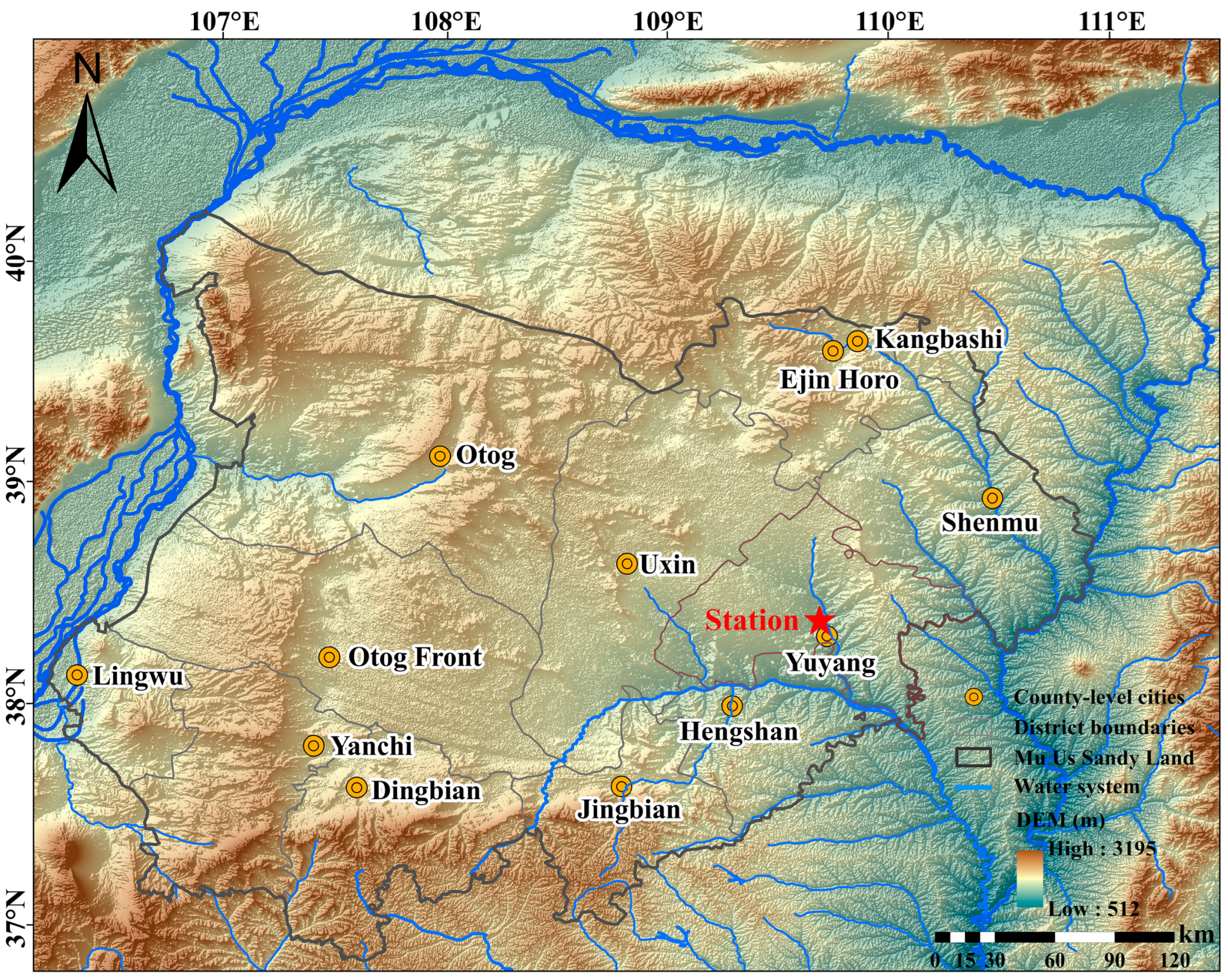


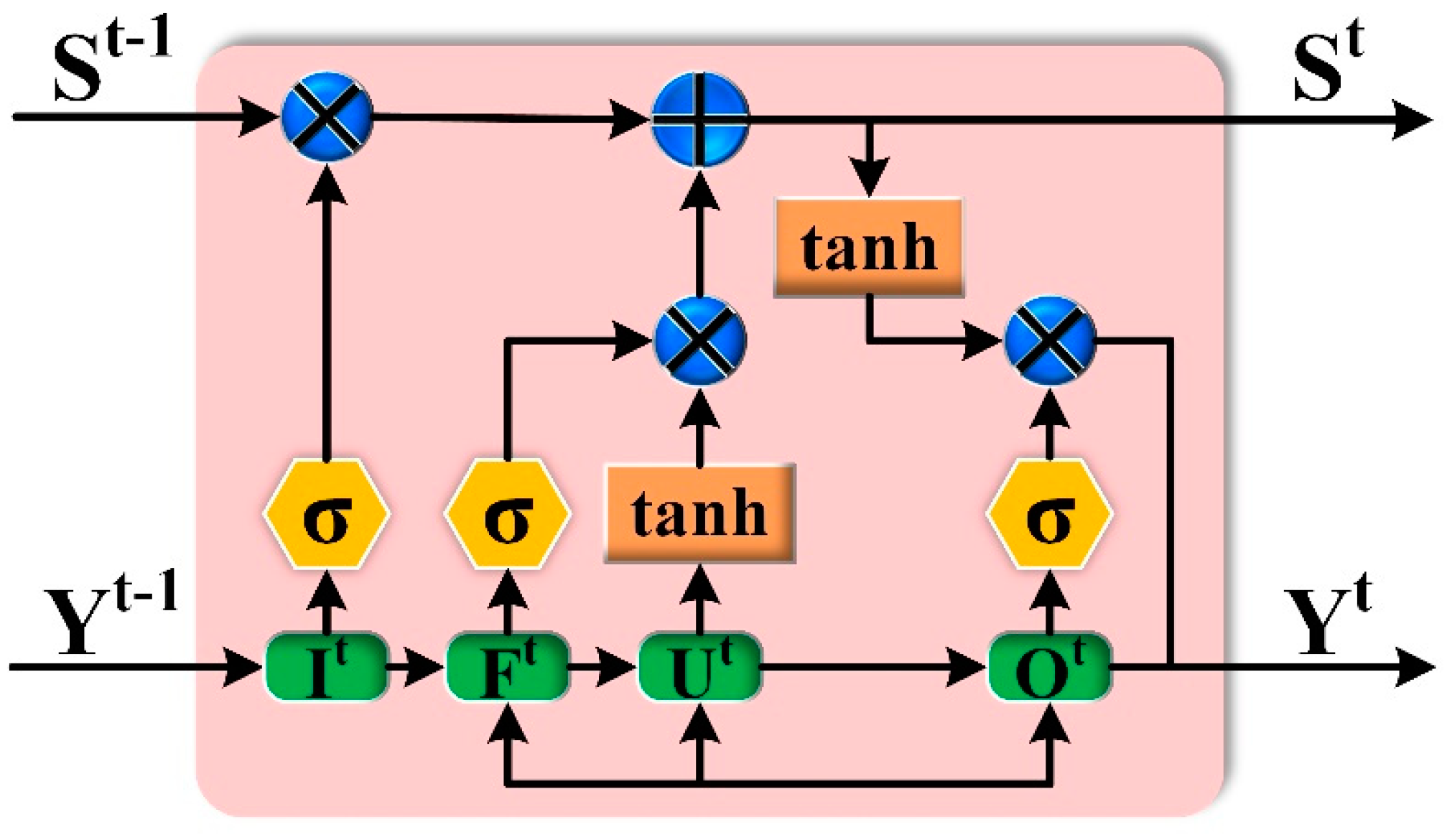
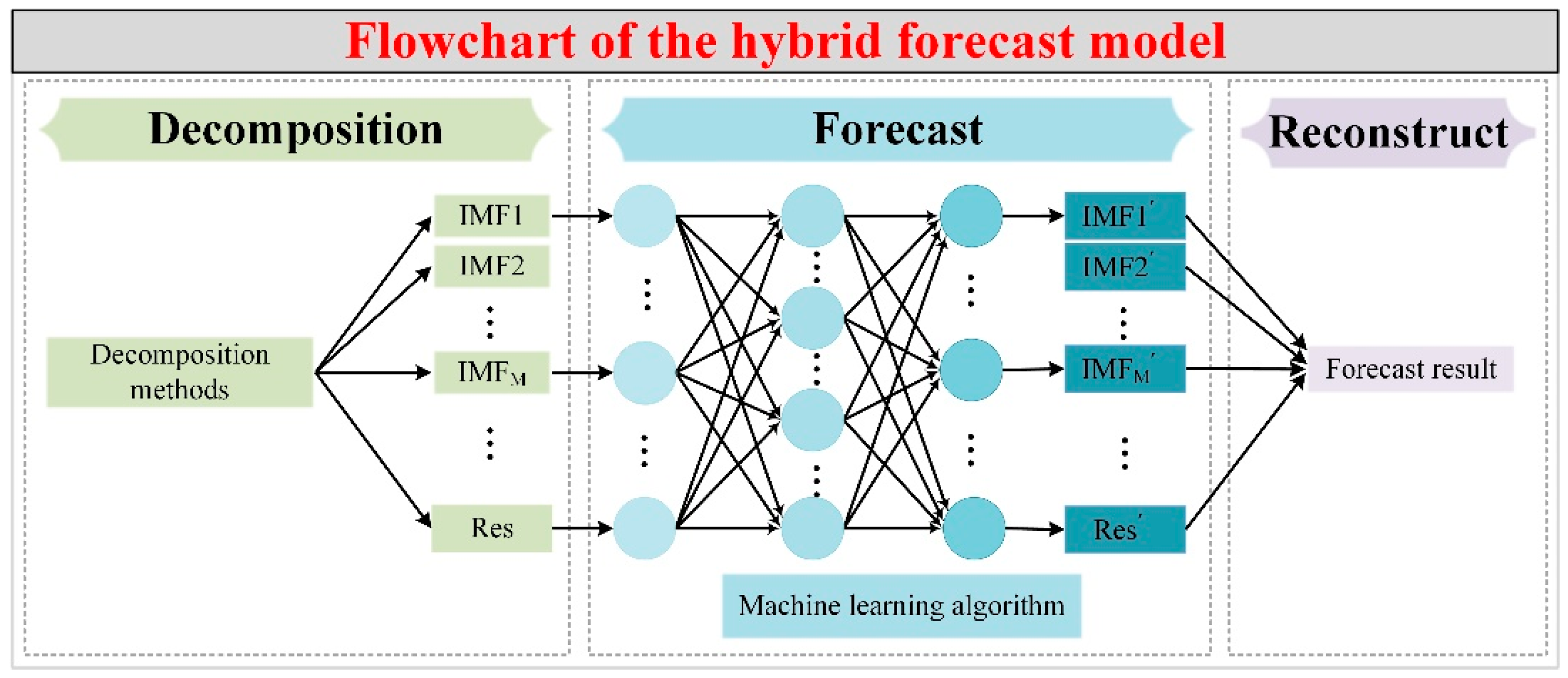
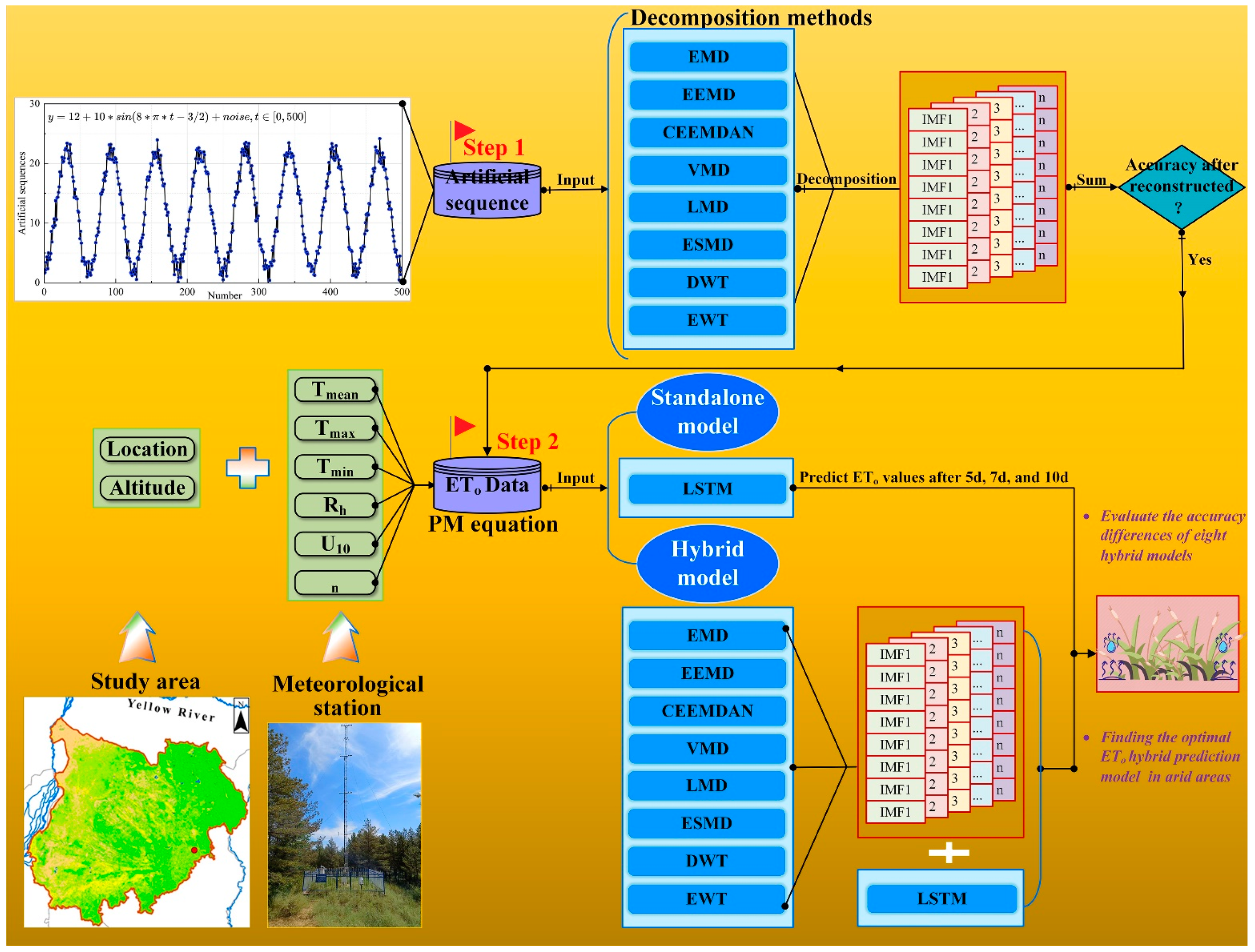

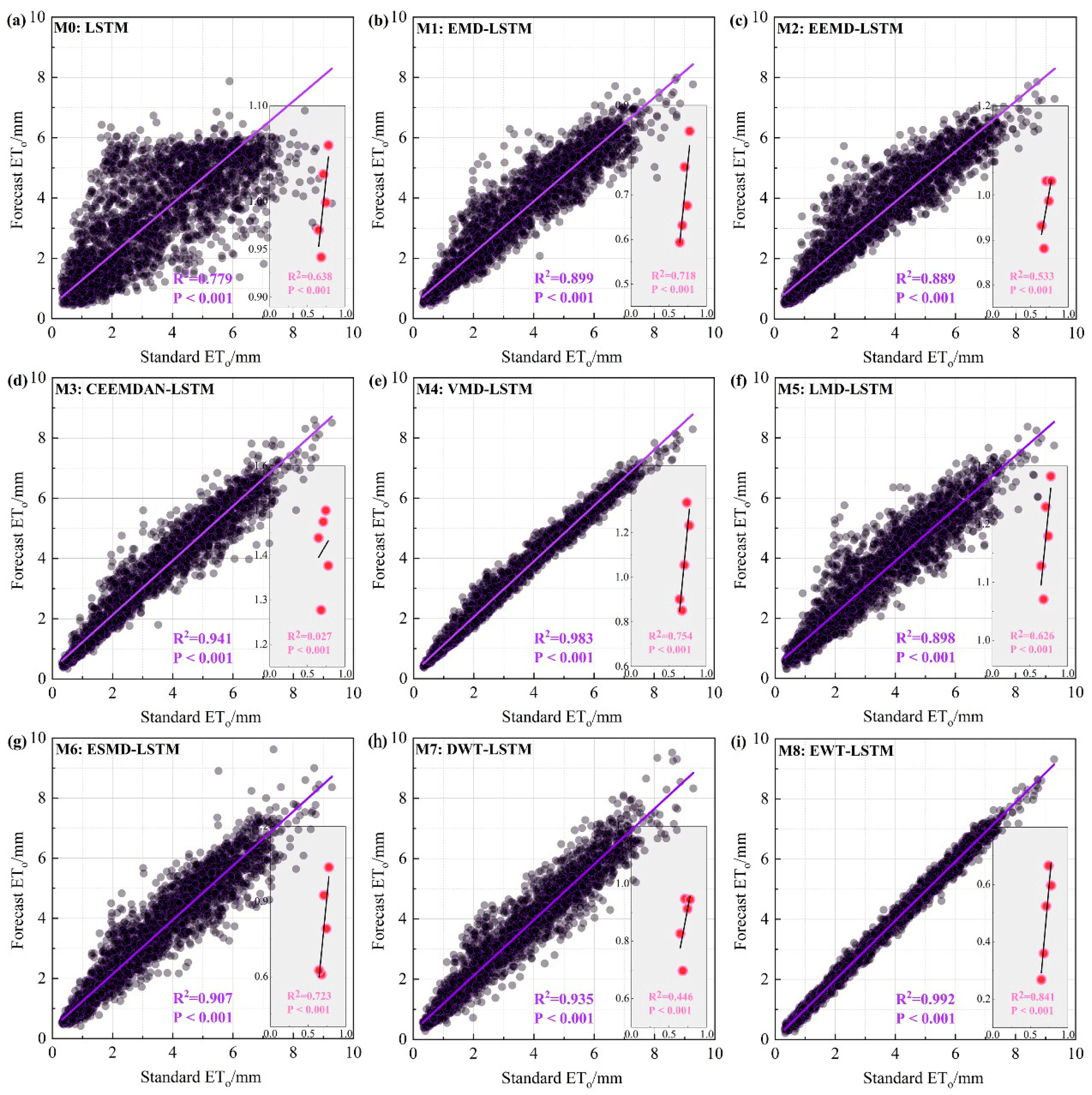
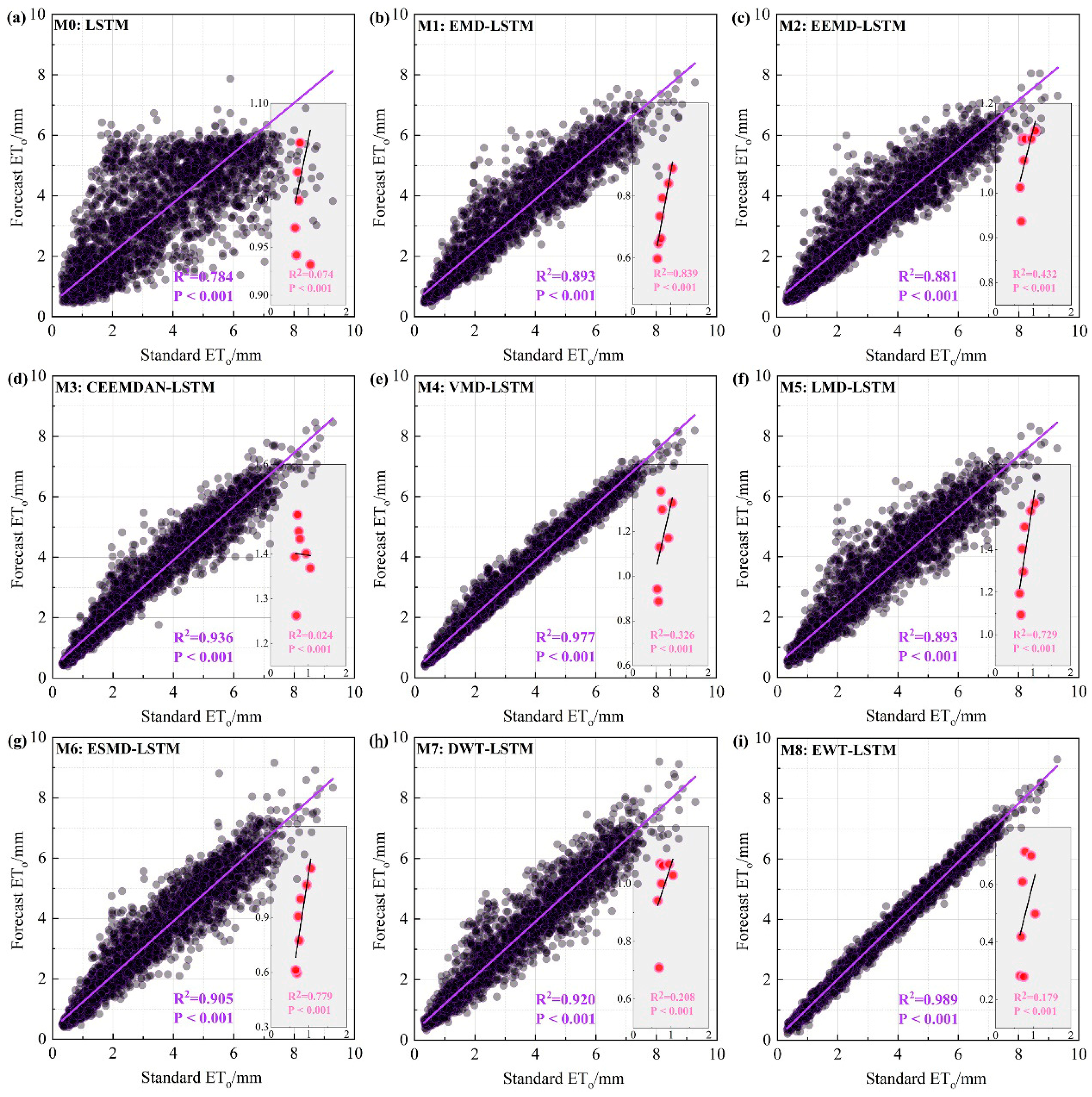


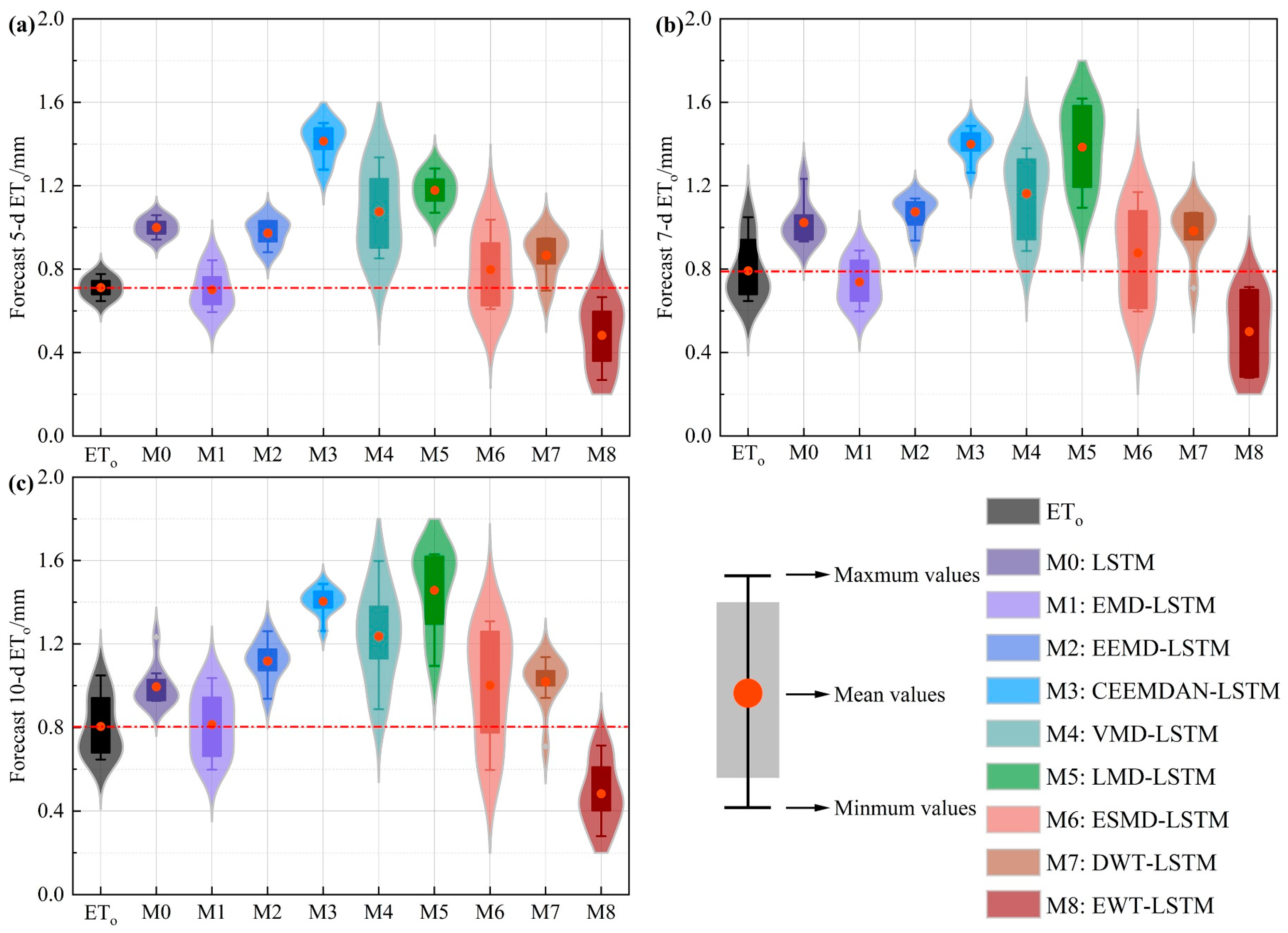
| Model | Number | Sum | Average | Variance | F-Value | p-Values | Difference Significant? |
|---|---|---|---|---|---|---|---|
| ETo | 2923 (5-days) | 9122.493 | 3.121 | 3.942 | - | - | - |
| M0 | 8992.026 | 3.076 | 2.951 | 0.845 | 0.358 | N | |
| M1 | 9165.941 | 3.136 | 3.242 | 0.090 | 0.764 | N | |
| M2 | 9196.112 | 3.146 | 3.093 | 0.264 | 0.608 | N | |
| M3 | 9181.587 | 3.141 | 3.423 | 0.162 | 0.687 | N | |
| M4 | 9036.122 | 3.091 | 3.424 | 0.347 | 0.556 | N | |
| M5 | 9175.254 | 3.139 | 3.361 | 0.130 | 0.718 | N | |
| M6 | 9226.005 | 3.156 | 3.536 | 0.490 | 0.484 | N | |
| M7 | 9212.231 | 3.152 | 3.602 | 0.365 | 0.546 | N | |
| M8 | 9035.326 | 3.091 | 3.835 | 0.334 | 0.563 | N | |
| ETo | 2925 (7-days) | 9124.484 | 3.120 | 3.942 | - | - | - |
| M0 | 8853.740 | 3.027 | 2.850 | 3.689 | 0.055 | N | |
| M1 | 9168.946 | 3.135 | 3.201 | 0.095 | 0.758 | N | |
| M2 | 9149.429 | 3.128 | 3.077 | 0.030 | 0.862 | N | |
| M3 | 9132.602 | 3.122 | 3.318 | 0.003 | 0.956 | N | |
| M4 | 9066.354 | 3.010 | 3.334 | 0.159 | 0.690 | N | |
| M5 | 9139.003 | 3.124 | 3.296 | 0.010 | 0.921 | N | |
| M6 | 9135.891 | 3.123 | 3.477 | 0.006 | 0.938 | N | |
| M7 | 9112.408 | 3.115 | 3.522 | 0.007 | 0.935 | N | |
| M8 | 9083.527 | 3.106 | 3.744 | 0.075 | 0.785 | N | |
| ETo | 2928 (10-days) | 9126.990 | 3.117 | 3.944 | - | - | - |
| M0 | 8856.531 | 3.025 | 2.852 | 3.676 | 0.055 | N | |
| M1 | 9171.911 | 3.133 | 3.202 | 0.097 | 0.756 | N | |
| M2 | 9153.073 | 3.126 | 3.077 | 0.033 | 0.856 | N | |
| M3 | 9136.846 | 3.121 | 3.318 | 0.005 | 0.946 | N | |
| M4 | 9070.584 | 3.098 | 3.334 | 0.149 | 0.699 | N | |
| M5 | 9143.889 | 3.123 | 3.295 | 0.014 | 0.908 | N | |
| M6 | 9139.766 | 3.122 | 3.476 | 0.008 | 0.931 | N | |
| M7 | 9115.694 | 3.113 | 3.523 | 0.006 | 0.939 | N | |
| M8 | 9084.852 | 3.103 | 3.747 | 0.079 | 0.779 | N |
| Model | R2 for 5-Days | R2 for 10-Days | R2 Degradation (%) |
|---|---|---|---|
| M0 | 0.638 | 0.017 | 97.30% |
| M1 | 0.718 | 0.381 | 46.90% |
| M2 | 0.533 | 0.294 | 44.80% |
| M3 | 0.027 | 0.012 | 55.50% |
| M4 | 0.754 | 0.204 | 72.90% |
| M5 | 0.626 | 0.447 | 28.60% |
| M6 | 0.723 | 0.400 | 44.70% |
| M7 | 0.446 | 0.209 | 53.10% |
| M8 | 0.841 | 0.073 | 91.30% |
| Model | Number | Sum | Average | Variance | F-Value | p-Values | Difference Significant? |
|---|---|---|---|---|---|---|---|
| ETo | 5-days | 3.557 | 0.711 | 0.003 | - | - | - |
| M0 | 4.998 | 0.100 | 0.002 | 87.278 | 0.000 | Y | |
| M1 | 3.506 | 0.701 | 0.010 | 0.040 | 0.846 | N | |
| M2 | 4.864 | 0.973 | 0.004 | 49.171 | 0.000 | Y | |
| M3 | 7.069 | 1.414 | 0.008 | 232.407 | 0.000 | Y | |
| M4 | 5.379 | 1.076 | 0.043 | 14.436 | 0.005 | Y | |
| M5 | 5.891 | 1.178 | 0.007 | 114.245 | 0.000 | Y | |
| M6 | 3.989 | 0.798 | 0.035 | 0.999 | 0.347 | N | |
| M7 | 4.330 | 0.866 | 0.011 | 8.573 | 0.019 | Y | |
| M8 | 2.415 | 0.483 | 0.027 | 8.701 | 0.018 | Y | |
| ETo | 7-days | 5.547 | 0.792 | 0.022 | - | - | - |
| M0 | 7.164 | 1.023 | 0.011 | 11.491 | 0.005 | Y | |
| M1 | 5.167 | 0.738 | 0.012 | 0.615 | 0.448 | N | |
| M2 | 7.525 | 1.075 | 0.006 | 20.374 | 0.000 | Y | |
| M3 | 9.798 | 1.400 | 0.005 | 95.336 | 0.000 | Y | |
| M4 | 8.135 | 1.162 | 0.036 | 16.432 | 0.002 | Y | |
| M5 | 9.695 | 1.385 | 0.040 | 40.010 | 0.000 | Y | |
| M6 | 6.143 | 0.878 | 0.050 | 0.703 | 0.418 | N | |
| M7 | 6.884 | 0.983 | 0.017 | 6.608 | 0.025 | Y | |
| M8 | 3.506 | 0.501 | 0.033 | 10.778 | 0.007 | Y | |
| ETo | 10-days | 8.051 | 0.805 | 0.020 | - | - | - |
| M0 | 9.950 | 0.995 | 0.009 | 12.203 | 0.003 | Y | |
| M1 | 8.141 | 0.814 | 0.023 | 0.019 | 0.892 | N | |
| M2 | 11.178 | 1.118 | 0.009 | 33.441 | 0.000 | Y | |
| M3 | 14.041 | 1.404 | 0.004 | 148.168 | 0.000 | Y | |
| M4 | 12.361 | 1.236 | 0.048 | 27.086 | 0.000 | Y | |
| M5 | 14.572 | 1.457 | 0.040 | 70.572 | 0.000 | Y | |
| M6 | 10.017 | 1.002 | 0.074 | 4.113 | 0.058 | N | |
| M7 | 10.182 | 1.018 | 0.015 | 12.978 | 0.002 | Y | |
| M8 | 4.829 | 0.483 | 0.024 | 23.685 | 0.000 | Y |
Disclaimer/Publisher’s Note: The statements, opinions and data contained in all publications are solely those of the individual author(s) and contributor(s) and not of MDPI and/or the editor(s). MDPI and/or the editor(s) disclaim responsibility for any injury to people or property resulting from any ideas, methods, instructions or products referred to in the content. |
© 2025 by the authors. Licensee MDPI, Basel, Switzerland. This article is an open access article distributed under the terms and conditions of the Creative Commons Attribution (CC BY) license (https://creativecommons.org/licenses/by/4.0/).
Share and Cite
Chen, Y.; Liu, Z.; Long, T.; Liu, X.; Gao, Y.; Wang, S. Evaluation of Eight Decomposition-Hybrid Models for Short-Term Daily Reference Evapotranspiration Prediction. Atmosphere 2025, 16, 535. https://doi.org/10.3390/atmos16050535
Chen Y, Liu Z, Long T, Liu X, Gao Y, Wang S. Evaluation of Eight Decomposition-Hybrid Models for Short-Term Daily Reference Evapotranspiration Prediction. Atmosphere. 2025; 16(5):535. https://doi.org/10.3390/atmos16050535
Chicago/Turabian StyleChen, Yunfei, Zuyu Liu, Ting Long, Xiuhua Liu, Yaowei Gao, and Sibo Wang. 2025. "Evaluation of Eight Decomposition-Hybrid Models for Short-Term Daily Reference Evapotranspiration Prediction" Atmosphere 16, no. 5: 535. https://doi.org/10.3390/atmos16050535
APA StyleChen, Y., Liu, Z., Long, T., Liu, X., Gao, Y., & Wang, S. (2025). Evaluation of Eight Decomposition-Hybrid Models for Short-Term Daily Reference Evapotranspiration Prediction. Atmosphere, 16(5), 535. https://doi.org/10.3390/atmos16050535







